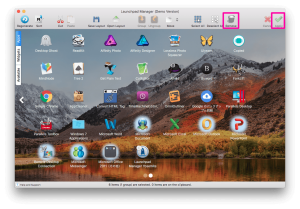

To perform the reset part of this operation, enter the following Terminal command:ĭefaults write ResetLaunchPad -bool TRUE

To set the column count, enter the following:ĭefaults write springboard-columns -int 4ĭefaults write springboard-rows -int 6įor these changes to take effect, you’ll need to reset and relaunch Launchpad. In this example, I’m editing the default grid to display 4×6 app icons.
LAUNCHPAD MANAGER PRO SERIES
You’ll then need to enter a series of commands by typing them into the Terminal and pressing your Mac’s ‘Enter’ key after each command. Start by opening the Terminal app, which you’ll find in your Mac’s Applications/Utilities folder. Changing the Launchpad Gridīy default, Launchpad displays application icons in a grid of 7 rows and 5 columns, but you can increase or decrease this number using your Mac’s Terminal application. Give this field a click and it’ll become editable.Īt this point you can create a new shortcut by holding down the combination of keys you want to use instead. Make sure ‘Launchpad & Dock’ is selected from the left-hand menu, then place your mouse over the current keyboard shortcut (where the cursor is positioned in the screenshot below). You can change this shortcut at any point by returning to the System preferences/Keyboard/Shortcuts menu. From now on, the Launchpad will appear whenever you press this key combination. Select the ‘Launchpad’ checkbox and then hold down the combination of keys you want to use as your shortcut. Make sure the ‘Shortcuts’ button is selected, then select ‘Launchpad & Dock’ from the left-hand menu. īut if none of these options work for you, you may want to create your own keyboard shortcut by opening your Mac’s ‘System preferences…’ and selecting ‘Keyboard.’.

Press the F4 key on your keyboard (also sometimes known as the ‘Launchpad key’). Pinch your trackpad using three fingers and your thumb.
LAUNCHPAD MANAGER PRO MAC
When it comes to opening your Launchpad, your Mac provides several options out-of-the-box:Ĭlick the Launchpad icon in your Mac’s Dock. At this point, the folder will disappear. To delete a folder, drag all apps from that folder. To remove an app from a folder, simply open that folder and drag the app in question outside of the grey box. Once you’ve created a folder, you can add more apps by dragging them onto the folder and then releasing them. In Launchpad, folders look a little different from the folders you see elsewhere on your Mac appearing as grey squares on the main Launchpad screen. If you want to change a folder’s name, open that folder, click its default title and then type one that’s more to your liking. Launchpad assigns each folder a name by default, which is usually pretty accurate (for example I created a folder containing the Messages and FaceTime apps, and Launchpad automatically assigned this folder the name ‘Social Networking’). Launchpad will create a new folder and place both app icons inside this folder. Drag one of these app icons onto the other and then, when a grey box appears, release your app icon. To create a folder, open Launchpad and find two apps that you want to place inside that folder. If your Launchpad is getting out of control, then one solution is to group related apps into folders.
LAUNCHPAD MANAGER PRO INSTALL
Grouping Apps into FoldersĮverytime you install an app, MacOS adds it to the Launchpad automatically, so if you’re an App Store addict then you can quickly end up with page after page of app icons. To create a new screen, drag an icon to the edge of a screen where you know there’s no more adjacent screens, and after a few moments Launchpad will create a new screen for you. When re-arranging your app icons, you may want to create additional screens for different groups of icons, for example you may want to move all the icons for apps you rarely use onto their own screen. After a few moments, Launchpad will switch to the next screen, ready for you to release your app icon. To move an icon to a different screen, simply drag it to the edge of the current screen. The dots that appear along the bottom of the Launchpad screen represent how many screens currently make up your Launchpad. However, it’s also worth noting that if there isn’t enough room to display all your apps on a single screen, Launchpad starts creating new screens automatically. Surely it makes sense for your most frequently-used apps to appear at the very top of your Launchpad?Īt its most basic, rearranging your app icons simply means dragging and dropping them to a new position within Launchpad. Launchpad is designed to provide a quick and easy way of launching your apps, but there’s always going to be some apps that you use more than others.


 0 kommentar(er)
0 kommentar(er)
